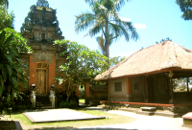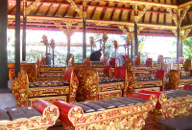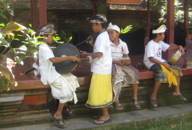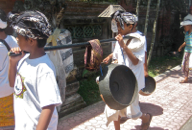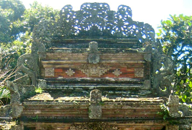Puri Saren palace
Ubud, CENTRAL BALI, INDONESIA
MARCH 29, 2009


Puri Saren palace
Ubud, CENTRAL BALI, INDONESIA
MARCH 29, 2009




The royal palace in the center of Ubud dates from the 1890’s, a time of the warlord Cokorda Gede Sukawati. The property is enclosed by elegantly carved gates and a beautiful brick and carved stone wall, the work of master artist, I Gusti Nyoman Lempad. Inside the palace grounds are several bale, roofed pavilions, their platforms raised to stage height above the ground. Many of these bale are elaborately carved and painted, with one, the music bale, being especially beautiful. Beneath its roof sat splendidly decorated instruments comprising a gamelan orchestra. This percussion ensemble consists of bronze metallophones (instruments with tuned metal keys), drums, and a few wind or string instruments. Gamelan orchestral music is based on rhythmic and melodic cycles punctuated by gongs. We saw many carved wooden instruments, each painted red and gilded with gold. These instruments included:
Gamelan • Gangsa (metallophones played in syncopation to create a complex melodic texture) • Male and Female Kendang (drums which conduct the orchestra) • Bronze Gongs, some in wooden frames, Gamelan Tingklik, or xylophone-type instruments with bamboo keys • Terampong (a series of inverted kettle gongs played by a single musician, and • Reyong (a row of small gongs played by a group of 2, 3 or 4 musicians.
When Henry and I visited the palace, a group of young boys, dressed in temple attire, were parading into the palace carrying gongs, drums, and cymbals. The boys were accompanying a four footed Barong, a hairy, dragon-like demon, its costume and antics performed by two of the boys. This monster represents order, harmony and health. He is pitted against the opposing force of Rangda, a fanged demon with a necklace of entrails, associated with chaos, harm, and illness. Periodically, the two contradictory forces are pitted against one another to restore balance to the community. These two forces enact a battle which culminates in a wild trance. The palace, or puri is very influential in the religious and cultural life of Ubud, spending lavishly on local ceremonies.
PHOTOS: Left Column: 1. Stone carved interior palace gate. 2. Interior palace grounds. 3. Decorative bale in the interior of the palace grounds. 4. Boys with their instruments, preparing to perform. Center, Top: Interior palace gate with guardian figure wrapped in a Poleng. Palm leaf offerings also adorn this figure. Center, Bottom: The Barong, a hairy demon representing order, harmony, and health. Two boys are under this costume. Right Column: 1. Carved stone and brick exterior palace gate. 2. A palace bale within the gates. 3. Beautifully painted and gilt instruments comprising the gamelan orchestra, all under an ornate pavilion where the musicians sit. 4. Boys on parade carrying gongs.

ROYAL PALACE


